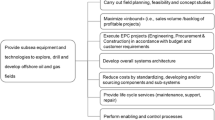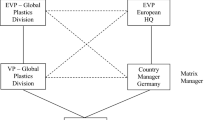Abstract
The matrix organization is a structural form characterized by dual (connected) hierarchies and multiple bases of departmentalization. Matrix organizations typically deploy functional departmentalization and product market departmentalization simultaneously. They are also used in project management contexts. The purpose of a matrix organization is to combine the benefits of functional specialization with a project or product market focus. The matrix structure is typically used when the organization needs in-depth functional skills and, at the same time, flexible and rapid adaption to changing environmental circumstances.
Access this chapter
Tax calculation will be finalised at checkout
Purchases are for personal use only
Similar content being viewed by others
References
Barney, J.B. 2011. Gaining and sustaining a competitive advantage. Upper Saddle River: Prentice Hall.
Bartlett, C.A., and S. Ghosal. 1990. Matrix management: Not a structure, a frame of mind. Harvard Business Review 68: 138–145.
Burns, L.R., and D.R. Wholey. 1993. Adoption and abandonment of matrix management programs: Effects of organizational characteristics and interpersonal networks. Academy of Management Journal 36: 106–138.
Davis, S.M., and P.R. Lawrence. 1977. Matrix. Reading: Addison-Wesley.
Davis, S.M., and P.R. Lawrence. 1978. Problems of matrix organizations. Harvard Business Review 56: 131–142.
Ford, R.C., and W.A. Randolph. 1992. Cross-functional structures: A review and integration of matrix organization and project management. Journal of Management 18: 267–294.
Galbraith, J.R. 1971. Matrix organization designs. Business Horizons 14: 29–40.
Kolodny, H.F. 1979. Evolution to a matrix organization. Academy of Management Review 4: 543–553.
Markides, C.C., and P.J. Williamson. 1996. Corporate diversification and organization structure: A resource-based view. Academy of Management Journal 39: 340–367.
Prahalad, C.K., and G. Hamel. 1990. The core competence of the corporation. Harvard Business Review 68: 79–91.
Author information
Authors and Affiliations
Corresponding author
Editor information
Editors and Affiliations
Copyright information
© 2018 Macmillan Publishers Ltd., part of Springer Nature
About this entry
Cite this entry
Turk, T.A. (2018). Matrix Organization. In: Augier, M., Teece, D.J. (eds) The Palgrave Encyclopedia of Strategic Management. Palgrave Macmillan, London. https://doi.org/10.1057/978-1-137-00772-8_743
Download citation
DOI: https://doi.org/10.1057/978-1-137-00772-8_743
Published:
Publisher Name: Palgrave Macmillan, London
Print ISBN: 978-0-230-53721-7
Online ISBN: 978-1-137-00772-8
eBook Packages: Business and ManagementReference Module Humanities and Social SciencesReference Module Business, Economics and Social Sciences




